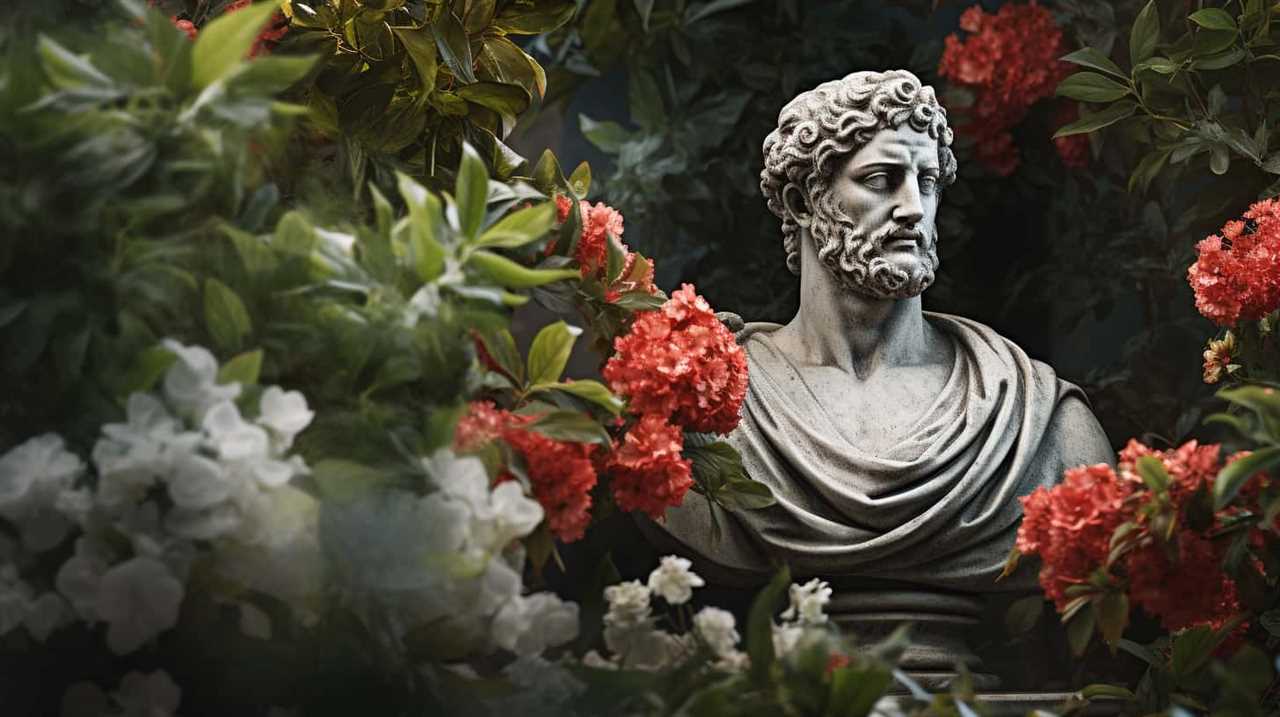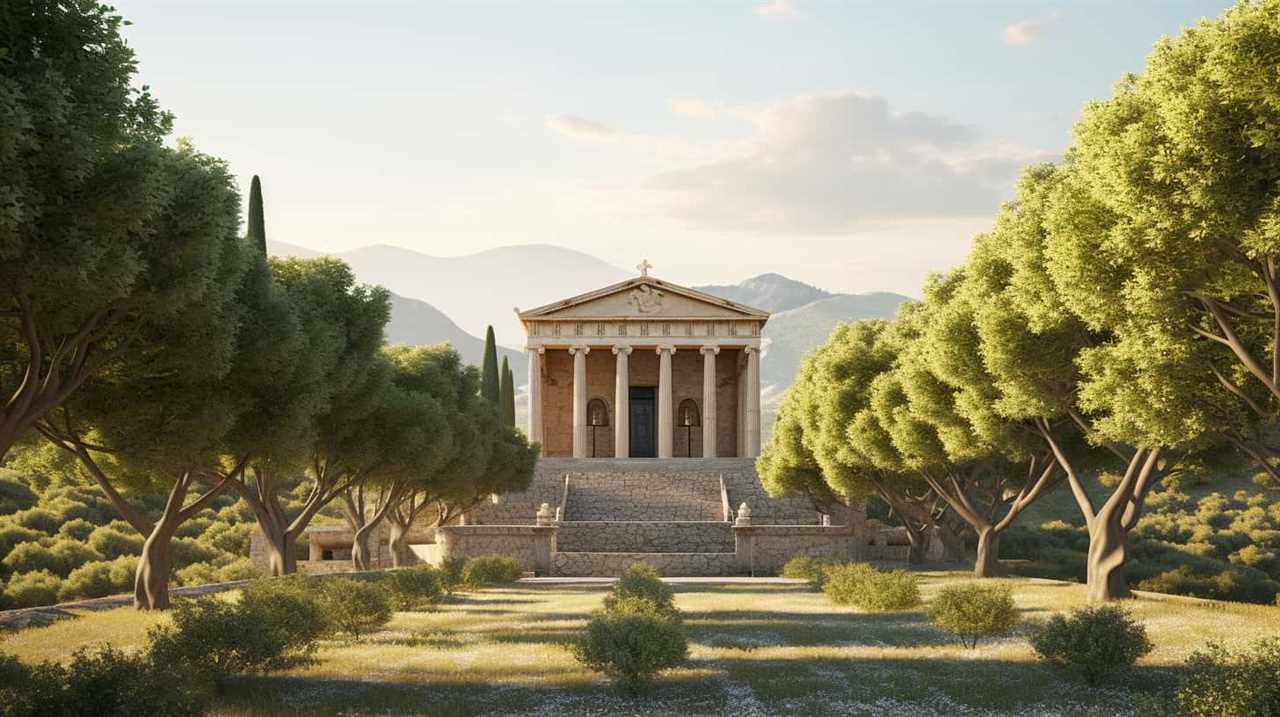Are you feeling frustrated while trying to navigate through Socrates’ dialogues like a blindfolded philosopher? Don’t worry, fellow seekers of wisdom! We have put together 13 essential tips to help you master the teachings of Socrates in his enlightening dialogues.
With our guidance, you will learn to navigate the labyrinthine structure of these conversations, decipher Socrates’ cunning questioning technique, and unravel the enigma of Socratic ignorance.
We will delve into the depths of self-knowledge and explore the ethical foundations that underpin these timeless discussions. By understanding the Socratic method of cross-examination, you will gain the tools to engage in intellectual combat.
So, join us on this journey of intellectual enlightenment as we unlock the secrets of Socrates’ dialogues and apply his teachings to our everyday lives.

Key Takeaways
- Foster critical thinking and self-reflection
- Promote self-reflection and personal growth
- Develop critical thinking skills and rational thinking
- Enhance active listening and empathy skills
The Importance of Socratic Dialogues
The importance of Socratic dialogues lies in their ability to foster critical thinking and self-reflection. Analyzing dialogue structure and engaging in meaningful conversations are key components of this process. Socratic dialogues provide a platform for individuals to critically examine their beliefs and ideas, encouraging them to question assumptions and seek deeper understanding.
By engaging in thoughtful conversations, participants are challenged to articulate their thoughts clearly and logically, while also considering alternative perspectives. This process of analysis and reflection helps individuals develop their critical thinking skills, enabling them to become more discerning and rational thinkers.
Furthermore, Socratic dialogues encourage individuals to explore their own beliefs and values, promoting self-reflection. Through this introspective process, participants are able to gain insight into their own thought processes and biases, leading to personal growth and self-awareness.
In addition, Socratic dialogues facilitate the exploration of complex ideas and concepts. By dissecting the structure of the dialogue, participants can identify logical fallacies, evaluate arguments, and recognize the strengths and weaknesses of different viewpoints. This analytical approach enhances intellectual rigor and promotes a deeper understanding of the subject matter.

In conclusion, the importance of Socratic dialogues can’t be overstated. They provide a unique opportunity for individuals to engage in meaningful conversations, analyze dialogue structure, and develop critical thinking abilities. By fostering intellectual growth and self-reflection, Socratic dialogues empower individuals to become more thoughtful and insightful thinkers.
Now, let’s delve into the subsequent section and analyze the structure of Socratic dialogues.
Analyzing the Structure of Socratic Dialogues
Now, let’s delve into how we can analyze the structure of Socratic dialogues to better understand Socrates’ teachings. By conducting a structure analysis of these dialogues, we can uncover the underlying framework that Socrates used to engage in his trademark Socratic questioning.
In order to illustrate this, let’s take a closer look at a table that breaks down the structure of a typical Socratic dialogue:

| Stage | Description |
|---|---|
| Introduction | Socrates introduces the topic and engages in casual conversation with his interlocutor. |
| Questioning | Socrates begins his method of inquiry by asking thought-provoking questions. |
| Elenchus | Socratic questioning intensifies, leading the interlocutor to question their own beliefs. |
| Conclusion | Socrates summarizes the dialogue and extracts a deeper understanding from his interlocutor. |
This structure analysis allows us to observe the progression of Socratic dialogues and the strategic use of questioning to guide the conversation towards a deeper understanding. Socrates employed this structure to challenge his interlocutors’ assumptions, expose contradictions in their beliefs, and ultimately lead them to a state of intellectual humility and self-reflection.
Understanding Socrates’ Questioning Technique
Socrates’ questioning technique is a powerful tool that enables us to engage in meaningful dialogue and uncover deeper truths. By employing effective questioning techniques, Socrates encourages us to think critically, challenge our assumptions, and explore different perspectives.
Through his skillful use of questions, Socrates facilitates a process of self-reflection and intellectual growth, prompting us to examine our beliefs and seek a deeper understanding of ourselves and the world around us.
Effective Questioning Techniques
One key aspect of understanding Socrates’ questioning technique is employing a variety of effective questioning techniques. In educational settings, effective questioning strategies play a crucial role in improving critical thinking skills. By utilizing these techniques, students are encouraged to think deeply, analyze information, and develop their own perspectives.

One effective questioning strategy is the use of open-ended questions that require thoughtful responses and promote discussion. These questions allow students to explore different viewpoints and consider alternative solutions.
Another technique is the use of probing questions, which delve deeper into a topic and encourage students to provide more detailed explanations. Additionally, using questioning techniques that challenge assumptions and encourage reflection can help students develop a more critical and analytical mindset.
By employing these effective questioning techniques, educators can create engaging learning environments that foster intellectual growth and mastery.
Transitioning into the subsequent section about ‘engaging through dialogue’, let’s now explore how Socrates’ dialogues can inspire meaningful discussions.

Engaging Through Dialogue
We frequently engage in meaningful dialogue to understand Socrates’ questioning technique and its impact on critical thinking skills.
To truly engage in dialogue and grasp the essence of Socratic questioning, it’s essential to practice active listening and foster empathy.
By actively listening, we not only hear the words spoken, but also pay attention to the underlying meaning and emotions conveyed. This allows us to better understand the perspective of the speaker and respond in a thoughtful manner.
Additionally, fostering empathy enables us to connect with others on a deeper level, opening up the possibility of genuine dialogue and mutual understanding.

Through these practices, we can fully engage in Socratic dialogue and develop our critical thinking skills to their fullest potential.
Uncovering Deeper Truths
To delve deeper into Socrates’ questioning technique and uncover profound truths, it’s crucial that we maintain an open mind and actively engage in the dialogue. Socrates believed that true knowledge could only be attained through critical thinking and questioning.
He used a method called the Socratic Method, which involved asking probing questions to challenge assumptions and stimulate deeper understanding. By constantly questioning, Socrates aimed to expose the limitations of our beliefs and encourage us to think critically about our own knowledge.
This technique forces us to examine our preconceived notions and consider alternative perspectives, leading to a more comprehensive understanding of the subject at hand. Through Socrates’ questioning technique, we can develop our critical thinking skills, enhance our ability to analyze complex ideas, and unlock deeper truths that may have been hidden beneath the surface.

Examining the Role of Irony in Socratic Dialogues
Examining the role of irony in Socratic dialogues involves analyzing the use of ironic language and its impact on the overall philosophical discourse. Irony, in this context, serves as a powerful teaching tool employed by Socrates to convey his philosophical ideas. Through the use of irony, Socrates adopts a seemingly ignorant or naive stance, engaging his interlocutors in a series of questions and answers. This technique, known as Socratic irony, encourages critical thinking and stimulates intellectual inquiry.
The role of irony in Socratic dialogues can be understood by considering the following points:
- Irony as a teaching tool:
- Socrates utilizes irony to challenge conventional wisdom and provoke deeper reflections in his interlocutors.
- By assuming a feigned ignorance, Socrates compels his interlocutors to critically examine their own beliefs and assumptions.
- Socratic irony and critical thinking:
- Socratic irony encourages individuals to question their own knowledge and engage in self-reflection.
- Through the use of irony, Socrates exposes contradictions and inconsistencies in his interlocutors’ arguments, promoting a deeper understanding of truth.
- Impact on the overall philosophical discourse:
- Irony in Socratic dialogues fosters an environment of intellectual engagement and active participation.
- By employing irony, Socrates challenges his interlocutors to think critically and arrive at their own conclusions, rather than passively accepting dogmas.
Unpacking the Concept of Socratic Ignorance
Let’s now explore the concept of Socratic ignorance and its significance in Socratic dialogues.
Socratic humility and knowledge play a crucial role in this concept, as they challenge our assumptions and invite us to question our own understanding.

Through the power of dialogue, Socrates encourages us to embrace our own ignorance in order to seek truth and wisdom.
Socratic Humility and Knowledge
Through engaging in Socratic dialogues, we gain a deeper understanding of the concept of Socratic ignorance and its connection to humility and knowledge.
Socratic humility is rooted in the recognition of our own limited understanding and the willingness to admit that we don’t possess all the answers. It’s a humble acknowledgment of our intellectual inadequacies and the constant pursuit of knowledge.
By embracing Socratic humility, we open ourselves up to the possibility of learning and growth, as it allows us to approach discussions with an open mind and a genuine curiosity. This humility is the foundation for the acquisition of knowledge, as it encourages us to question, explore, and challenge our assumptions.

Through Socratic dialogues, we embark on a journey of intellectual discovery, constantly seeking to expand our understanding and refine our beliefs.
Now, let’s explore how challenging assumptions through dialogue can further enhance our grasp of Socrates’ teachings.
Challenging Assumptions Through Dialogue
How can we challenge our assumptions and unpack the concept of Socratic ignorance through engaging in dialogue?
Challenging assumptions is a fundamental aspect of Socratic dialogue, as it promotes critical thinking and encourages individuals to question their preconceived notions. By engaging in thoughtful and analytical conversations, we have the opportunity to examine our beliefs and challenge the validity of our assumptions.

Socratic ignorance, or the recognition of our own lack of knowledge, is a powerful tool that can be used to break down barriers and open our minds to new perspectives. Through dialogue, we can confront our assumptions head-on, allowing for a deeper understanding of ourselves and the world around us.
Exploring the Themes of Virtue and Morality
As we delve into Socrates’ dialogues, it becomes evident that the exploration of themes of virtue and morality holds a crucial place in our understanding of his teachings. Socrates believed that true wisdom lies in understanding and practicing virtue, and he devoted much of his dialogues to the exploration of what it means to be virtuous and how it relates to morality.
In his dialogues, Socrates engaged in deep conversations with his interlocutors, questioning their beliefs and challenging their assumptions about what’s moral and virtuous. Through these dialogues, Socrates aimed to uncover the true nature of virtue and morality and to help his interlocutors develop a more nuanced understanding of these concepts.
Virtue exploration:

- Socrates believed that virtue isn’t simply a matter of following societal norms or customs.
- He argued that true virtue is a form of knowledge and requires self-examination and introspection.
- Socrates encouraged his interlocutors to question their own beliefs and motivations in order to cultivate true virtue.
Morality analysis:
- Socrates challenged the prevailing ideas of morality in ancient Athens.
- He believed that morality should be based on reason and rationality, rather than on tradition or divine command.
- Socrates emphasized the importance of moral consistency and the pursuit of the greater good.
Applying Socratic Methods to Modern-Day Conversations
When it comes to applying Socratic methods to modern-day conversations, there are several practical application tips that can help us navigate these discussions effectively.
By embracing the Socratic approach of questioning and critical thinking, we can encourage open-mindedness and intellectual growth in our conversations.
However, we must also be aware of the challenges posed by modern communication, such as the prevalence of quick and shallow exchanges, and actively work to overcome them in order to fully benefit from the Socratic method.

Practical Application Tips
To apply Socratic methods to modern-day conversations, we can employ the use of active questioning techniques and engage in open-minded discussions. By implementing these strategies, we can enhance our ability to critically analyze ideas and stimulate meaningful conversations.
Here are some practical application tips for incorporating Socratic methods into our daily interactions:
- Real life application:
- Begin by identifying a topic or issue that prompts critical thinking and reflection.
- Use open-ended questions to encourage deeper exploration and understanding.
- Encourage others to provide evidence and reasoning to support their viewpoints.
- Practical implementation:
- Foster a safe and respectful environment that promotes open dialogue.
- Practice active listening to fully understand others’ perspectives.
- Challenge assumptions and explore alternative viewpoints to broaden the discussion.
Benefits of Socratic Approach
By applying the Socratic approach to modern-day conversations, we can reap the benefits of fostering critical thinking and promoting meaningful dialogue. One of the advantages of inquiry-based learning is that it encourages individuals to question assumptions and explore different perspectives.
Through the Socratic method, we can challenge traditional modes of thinking and encourage a deeper understanding of complex issues. This approach also cultivates critical thinking skills, allowing individuals to analyze information, evaluate arguments, and make informed decisions.

Moreover, by engaging in Socratic dialogue, we can develop a greater capacity for empathy and active listening, fostering a sense of respect and understanding among participants.
Ultimately, the Socratic approach enables us to navigate the complexities of modern-day conversations, leading to more meaningful and productive discussions.
Overcoming Modern Communication Challenges
Applying the Socratic approach to modern-day conversations allows us to overcome modern communication challenges and foster meaningful dialogue. In today’s fast-paced world, communication barriers have become increasingly prevalent, hindering effective communication and understanding. However, by incorporating Socratic methods into our conversations, we can address these challenges head-on and create more productive and fulfilling interactions.
To overcome communication barriers, we can:

- Practice active listening: By fully engaging in the conversation and giving our undivided attention to the speaker, we can better understand their perspective and respond thoughtfully.
- Ask thought-provoking questions: Socratic questioning encourages deeper thinking and reflection, helping to uncover underlying assumptions and biases that may obstruct effective communication.
- Create a safe and respectful environment: By fostering an atmosphere of trust and respect, we can encourage open and honest dialogue, allowing for differing viewpoints to be shared without fear of judgment or ridicule.
Recognizing Logical Fallacies in Socratic Dialogues
In our study of Socratic dialogues, we’ve discovered several common logical fallacies that we must be able to recognize and analyze. Identifying fallacious reasoning is essential in order to fully grasp the teachings of Socrates. Logical reasoning in dialogues is a fundamental aspect of Socratic philosophy, and being able to distinguish between valid and fallacious arguments is crucial for developing a strong understanding of his teachings.
One common logical fallacy that often arises in Socratic dialogues is the ad hominem fallacy. This occurs when an individual attacks the character or personal qualities of their interlocutor instead of addressing the substance of their argument. By recognizing this fallacy, we can avoid getting sidetracked by personal attacks and focus on the logical merits of the argument being presented.
Another fallacy frequently encountered in Socratic dialogues is the appeal to authority. This occurs when someone relies on the opinion or testimony of an authority figure without providing any substantive evidence or reasoning to support their position. By being aware of this fallacy, we can critically evaluate the arguments being made and avoid blindly accepting claims based solely on the authority of the person making them.
Interpreting Socrates’ Views on Democracy
Our understanding of Socrates’ views on democracy can be deepened by examining his dialogues. Socrates’ critique of democracy was rooted in his belief that the majority’s decision-making could be easily swayed by emotions and personal interests rather than reason and knowledge. Through his dialogues, Socrates employed a technique known as Socratic irony, where he pretended to be ignorant and engaged in a series of questioning to expose the flaws in his interlocutors’ arguments.

To interpret Socrates’ views on democracy, we can consider the following:
- Socratic irony: Socrates often used irony to reveal the contradictions and inconsistencies in the arguments presented by supporters of democracy. By highlighting the limitations of democratic decision-making, Socrates aimed to encourage individuals to question their own beliefs and seek a deeper understanding of truth.
- Emphasis on reason: Socrates believed that true knowledge could only be attained through rational thinking and inquiry. He argued that democracy, with its emphasis on popular opinion, could lead to decisions that weren’t based on sound reasoning. Socrates advocated for the importance of relying on intellectual examination rather than the majority’s whims.
- Critique of demagogues: Socrates was wary of the influence of charismatic leaders, known as demagogues, in a democratic society. He believed that demagogues could manipulate public opinion by appealing to emotions and exploiting the ignorance of the masses. Socrates cautioned against blindly following such leaders and encouraged individuals to question the motives and reasoning behind their rhetoric.
Delving Into the Concept of Self-Knowledge
To further explore Socrates’ teachings and delve into the concept of self-knowledge, we frequently encounter his emphasis on introspection and reflection in his dialogues. Socrates believed that true wisdom begins with self-reflection and self-awareness. Through his method of questioning, he aimed to guide others towards a deeper understanding of themselves and their beliefs. By engaging in thoughtful dialogue, individuals were encouraged to examine their own thoughts and assumptions, and to critically evaluate their own knowledge.
One key aspect of self-knowledge emphasized by Socrates is the recognition of one’s own ignorance. Socrates famously declared that he was the wisest man because he was aware of his own lack of knowledge. This acknowledgment of our own limitations is crucial in the pursuit of self-knowledge, as it allows us to approach learning with an open mind and humility.
| Self-Reflection | Self-Awareness | |
|---|---|---|
| 1. | Involves examining one’s thoughts, emotions, and actions. | Involves understanding one’s strengths, weaknesses, and values. |
| 2. | Helps uncover subconscious biases and hidden motivations. | Helps recognize patterns in behavior and relationships. |
| 3. | Facilitates personal growth and development. | Enables better decision-making and problem-solving. |
Examining the Role of Ethics in Socratic Dialogues
Throughout Socratic dialogues, we frequently explore the role of ethics by actively examining the moral principles and values that guide our actions. The interplay between ethics and Socratic dialogues is crucial, as it allows us to delve deep into the ethical implications of our beliefs and actions. By engaging in these dialogues, we’re able to critically analyze and evaluate the ethical dimensions of various topics, such as justice, virtue, and the nature of good. This examination of ethics allows us to question and challenge our own moral compass, leading to a deeper understanding of our values and principles.

In exploring the role of ethics in Socratic dialogues, we come across several important aspects:
- Ethical inquiry: Socratic dialogues serve as a platform for ethical inquiry, where we question and examine our ethical beliefs and assumptions. This process encourages introspection and self-reflection, enabling us to gain a clearer understanding of our moral values.
- Moral reasoning: Socratic dialogues provide an opportunity to engage in moral reasoning, where we analyze and evaluate different ethical arguments. Through logical reasoning and critical thinking, we can assess the validity and cogency of ethical claims and positions.
- Ethical development: By actively engaging in Socratic dialogues, we can foster ethical development. Through the exchange of ideas and perspectives, we can expand our ethical knowledge and refine our moral judgment.
The role of ethics in Socratic dialogues is instrumental in shaping our understanding of moral principles and values. It allows us to critically examine our own beliefs and actions, leading to ethical growth and development. By actively participating in Socratic dialogues, we can cultivate a more thoughtful and ethical approach to our lives.
Understanding the Socratic Method of Cross-Examination
As we delve deeper into Socrates’ teachings, let us now explore the Socratic Method of Cross-Examination. This method is at the heart of Socratic dialogues and is a powerful tool for effective questioning strategies and developing critical thinking skills. Through the Socratic Method, Socrates engaged in a rigorous process of inquiry, challenging his interlocutors’ beliefs and assumptions, and encouraging them to examine the logical consistency and coherence of their arguments.
To better understand the Socratic Method of Cross-Examination, let’s consider the following three features that make it so effective:

| Features | Explanation | Emotion |
|---|---|---|
| Elicits deeper thinking | The method prompts individuals to reconsider their beliefs and explore underlying assumptions. | Curiosity |
| Challenges preconceptions | By questioning assumptions, it encourages individuals to critically evaluate their own arguments. | Surprise |
| Fosters intellectual growth | The Socratic Method stimulates intellectual development and enhances analytical skills. | Empowerment |
By employing these aspects, the Socratic Method of Cross-Examination enables individuals to go beyond surface-level understanding and engage in profound introspection and critical analysis. It is a transformative tool that cultivates intellectual rigor and helps individuals develop the ability to think critically and question deeply.
With a solid understanding of the Socratic Method of Cross-Examination, we can now move on to exploring how to implement Socrates’ teachings in everyday life.
Implementing Socrates’ Teachings in Everyday Life
We can apply Socrates’ teachings in everyday life by applying critical thinking skills and embracing the Socratic Method of cross-examination. By incorporating these techniques into our daily routines, we can enhance our ability to question and analyze the world around us.
Here are three ways to implement Socrates’ teachings in everyday life:

- Engage in self-reflection: Take the time to critically examine your own beliefs, assumptions, and values. Ask yourself why you hold certain opinions and whether they’re based on evidence or mere conjecture. By actively questioning your own thoughts, you can develop a deeper understanding of yourself and the world.
- Foster open dialogue: Encourage meaningful conversations with others by adopting the Socratic Method of cross-examination. Instead of simply accepting what someone says, engage in a thoughtful exchange of ideas. Ask probing questions to uncover biases, challenge assumptions, and promote critical thinking.
- Seek diverse perspectives: Actively seek out diverse viewpoints and engage with them respectfully. Surround yourself with people who’ve different backgrounds, experiences, and beliefs. By exposing yourself to a variety of perspectives, you can broaden your understanding and challenge your own biases.
Frequently Asked Questions
How Can Socratic Dialogues Be Applied to Modern-Day Conversations?
When applying Socratic dialogues in modern-day conversations, we can utilize the Socratic method in problem-solving. By asking thoughtful questions, challenging assumptions, and seeking deeper understanding, we can foster critical thinking and meaningful discourse.
What Are Some Common Logical Fallacies Found in Socratic Dialogues?
In Socratic dialogues, we often encounter the straw man fallacy, where an opponent misrepresents their opponent’s argument. Additionally, the ad hominem fallacy is prevalent, where personal attacks are used instead of addressing the argument directly.
How Does Socrates View Democracy?
Socrates’ perspective on democracy is a subject of debate. Through his Socratic approach to government, he questioned the role of the masses in decision-making, emphasizing the importance of knowledge and virtue over popular opinion.
How Can Socratic Teachings Be Implemented in Everyday Life?
Implementing Socratic teachings in everyday life requires adopting the Socratic approach and employing critical thinking techniques. By constantly questioning assumptions, examining beliefs, and seeking truth, we can cultivate a deeper understanding of ourselves and the world around us.

What Is the Role of Ethics in Socratic Dialogues?
Ethics play a pivotal role in Socratic dialogues as they provide a framework for critical thinking and moral reasoning. By examining our actions and beliefs, we can cultivate virtue and strive for a more just and ethical society.
How Can Socrates’ Dialogues Help in Understanding Vedic Scripture Quotes?
Socrates’ dialogues offer a unique perspective on exploring philosophical concepts, and they can complement the study of Vedic scripture quotes for spirit. By analyzing Socratic discussions, readers can gain insights into the deeper meanings and implications of the ancient Vedic teachings, fostering a more comprehensive understanding of spirituality.
Conclusion
In conclusion, Socratic dialogues provide valuable insights into philosophical teachings that can be applied to our everyday lives. By analyzing the structure and questioning techniques employed by Socrates, we can gain a deeper understanding of ourselves and the world around us.
For example, imagine a scenario where a person is struggling with a moral dilemma. By using the Socratic method of cross-examination, they can examine their own beliefs and values to make a more informed decision.
Implementing Socrates’ teachings allows us to navigate complex situations with clarity and wisdom.

Lauren’s talent in writing is matched by her passion for storytelling. Her love for books and deep understanding of culture and entertainment add a distinct flavor to her work. As our media and press contact, Lauren skillfully bridges the gap between afterQuotes and the broader media landscape, bringing our message to a wider audience.










